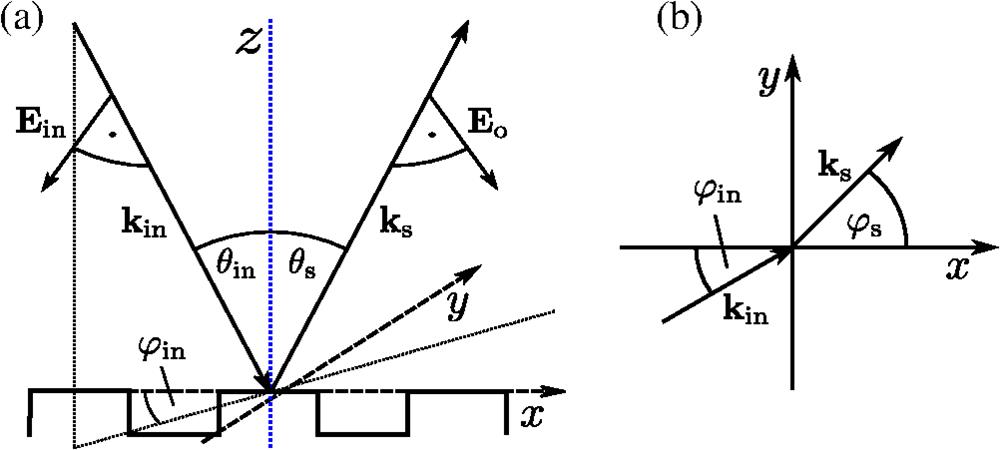Tobias Pahl, Felix Rosenthal, Johannes Breidenbach, Corvin Danzglock, Sebastian Hagemeier, Xin Xu, Marco Künne, Peter Lehmann, "Electromagnetic modeling of interference, confocal, and focus variation microscopy," Adv. Photon. Nexus 3, 016013 (2024)
Search by keywords or author
- Advanced Photonics Nexus
- Vol. 3, Issue 1, 016013 (2024)

Fig. 1. Sketch of the scattering geometry including definitions of wave vectors, electric fields, and angles of incidence in (a)

Fig. 2. Schematic representations of (a) a coherence scanning interferometer in Linnik configuration, (b) a confocal microscope with spinning disk for lateral scanning, and (c) a focus variation microscope with ring light illumination. The illumination beam path is sketched in red (bright-field), the imaging beam path in blue, and the dark-field ring light (RL) is shown in green in the case of FVM. D, diffuser; CL, condenser lens; RM, reference mirror; MO, microscope objective; BSC, beam splitter cube; TL, tube lens; C, camera; PS, piezo stage; S, sample; PHD, pinhole disk; and FL, field lens.
Fig. 3. (a), (c) Simulated and (b), (d) measured results for a sinusoidal surface profile of period length
Fig. 4. (a), (c) Simulated and (b), (d) measured results from a sinusoidal surface profile of period length
Fig. 5. (a) Simulated and (b) measured intensity responses obtained from a sinusoidal surface profile of period length
Fig. 6. (a), (c), (e) Simulated and (b), (d), (f) measured normalized intensity depth responses obtained from a sinusoidal surface profile of period length
Fig. 7. Surface profiles (eval.) obtained from (a) simulated and (b) measured depth response signals depicted in Figs. 6(e) and 6(f) , respectively. The reference profiles (ref.) are given by the nominal surface in the case of simulation and by tactile stylus measurement in the experimental case. (c) Normalized depth response signals obtained from the same sinusoidal surface profile shown as ref. In (a), superimposed with roughness of
Fig. 8. Extracts of measured surface topographies obtained by a (a) Mirau and (b) Linnik interferometer as well as a (c) confocal microscope. The sections, where the profiles shown in Figs. 3 –5 are extracted, respectively, are marked by black lines. The CSI results are obtained by phase analysis.
Fig. 9. Results obtained from a sinusoidal surface profile of period length

Set citation alerts for the article
Please enter your email address



